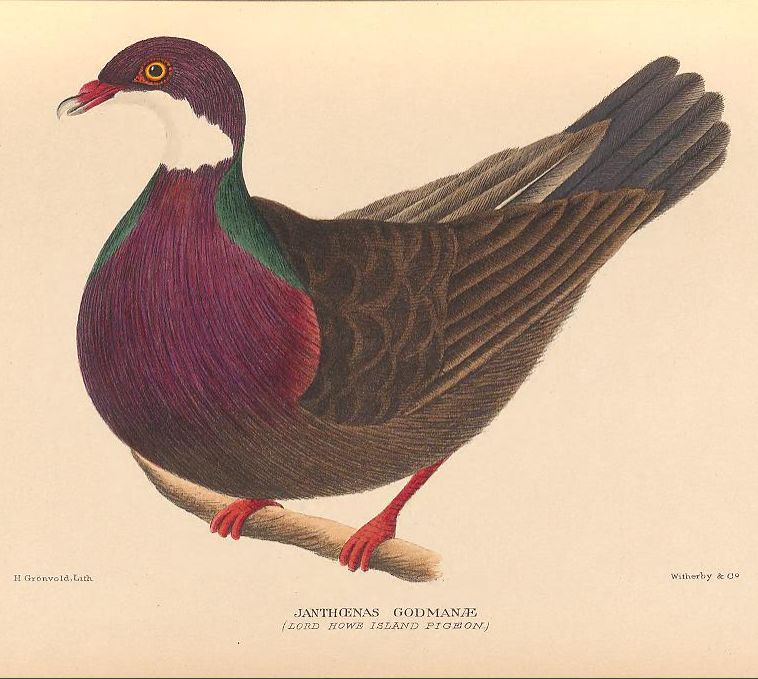Columba vitiensis godmanae (Mathews, 1915:24)
White-throated pigeon, Lord Howe (Island) pigeon
Taxonomy & Nomenclature
Synonym/s: Raperia godmanae Mathews, 1915:24 (original combination); Janthoenas godmanae (Mathews, 1915:24); Janthoenas godmani (Mathews, 1915:24)
Conservation Status
Extinct
Last record: mid-1800's (McAllan et al. 2004); 1853 (May or before) (MacDonald, 1853; Hindwood, 1940; Day, 1981; Hutton, 1991:59; Garnett, 1992:70; Hume & Walters, 2012:139)
IUCN RedList status: Extinct
Distribution
Lord Howe Island, New South Wales, Australia
Biology & Ecology
Hypodigm
No specimens were ever preserved and the original description was based upon a painting (Mathews, 1915). The diaries of several sailors contain mentions of large, blue pigeons from the island which presumably refer to this species ([i]fide[/i] Day, 1981).
Media

Above: plate from Mathews (1928).
References
Original scientific description:
Mathews, G. M. (1915). Raperia godmanae, a new bird from Lord Howe Island, now extinct. Austral Avian Records 3: 21-24.
Other references:
Day, David. (1981). The Doomsday Book of Animals: A Natural History of Vanished Species. New York, N.Y.: The Viking Press.
Department of Environment and Climate Change (NSW). (2007). Lord Howe Island Biodiversity Management Plan Appendices. Department of Environment and Climate Change (NSW), Sydney. vii + 267 pp.
Department of Sustainability, Environment, Water, Population and Communities (2012). Columba vitiensis godmanae in Species Profile and Threats Database, Department of Sustainability, Environment, Water, Population and Communities, Canberra. Available from: http://www.environment.gov.au/sprat. Accessed Mon, 26 Nov 2012 21:47:04 +1100.
Etheridge, R. (1889). The general zoology of Lord Howe Island; containing also an account of the collections made by the Australian Museum Collecting Party, Aug.–Sept., 1887. Australian Museum Memoir 2(1): 1-42, plates iv–v.
Fisher, Clemency T. and Warr, F. E. (2003). Museums on paper: library & manuscript resources. Bulletin of the British Ornithologists' Club 123A: 136-164.
Garnett, Stephen (ed.). (1992). Threatened and Extinct Birds of Australia. RAOU Report Number 82. 212 pp.
Garnett, S. T. and Crowley, G. M. (2000). The Action Plan for Australian Birds 2000. Canberra, ACT: Environment Australia & Birds Australia.
Gilbert, T. (1789). Voyage from New South Wales to Canton in the year 1788. London: Debrett.
Greenway James C. (1967). Extinct and Vanishing Birds of the World. American Committee for International Wild Life Protection, Special Publication no 13, 2nd edn. Dover Publications, New York.
Hill, Edward S. (1870). Lord Howe Island. Official visit by the Water Police Magistrate and the Director of the Botanic Gardens, Sydney; together with a description of the island. In: New South Wales Parliamentary Papers (Votes and Proceedings) 1: 635-654.
Hindwood, Keith A. (1938). The extinct birds of Lord Howe Island. Australian Museum Magazine 6(9): 319-324.
Hindwood, Keith A. (1940). The birds of Lord Howe Island. Emu 40: 1-86.
Hindwood, Keith A. (1964). George Raper: an artist of the First Fleet. J. R.Aust. Hist. Soc. 50: 32-57.
Hindwood, Keith A. (1965). John Hunter: A naturalist and artist of the First Fleet. Emu 65: 83-95.
Hume, Julian Pender and Walters, Michael. (2012). Extinct Birds. London: T & AD Poyser.
Hutton, Ian. (1991). Birds of Lord Howe Island: Past and Present. Coffs Harbour Plaza, N.S.W.: Self Published. 154 pp.
Knox, Alan G. and Walters, Michael P. (1994). Extinct and endangered birds in the collections of The Natural History Museum. British Ornithologists' Club Occasional Publications 1: 1-292.
MacDonald, J. D. (1853). Remarks on the natural history and capabilities of Lord Howe Island, in correspondence relative to a proposed penal settlement on Lord Howe Island. Votes and Proceedings of the Legislative Council, Sydney, Dec. 9 2: 715-733.
Mathews, Gregory Macalister. (1928). The Birds of Norfolk & Lord Howe Islands and the Australasian South Polar Quadrant: with additions to "birds of Australia". London: H.F. & G. Witherby. [p. 2, pl. 2]
Matthews, Thomas J. et al. (2022). Threatened and extinct island endemic birds of the world: Distribution, threats and functional diversity. Journal of Biogeography. https://doi.org/10.1111/jbi.14474
Mayr, Ernst. (1941). Taxonomic notes on the birds of Lord Howe Island. Emu 40: 321-322.
McAllan, Ian A. W., Curtis, Brian R., Hutton, Ian and Cooper, Richard M. (2004). The Birds of Lord Howe Island Group: A Review of Records. Australian Field Ornithology 21(Supplement): 1-82.
McKean, J. L. and Hindwood, K. A. (1965). Additional notes on the birds of Lord Howe Island. Emu 64: 79-97
Paramonov, S. J. (1960). Lord Howe Island, a Riddle of the Pacific. Part II. Pacific Science 14: 75-85.
Recher, H. F. (1974). Colonisation and extinction: the birds of Lord Howe Island. Australian Natural History 18(2): 64-69.
Tyrberg, Tommy. (2009). Holocene avian extinctions, pp. 63-106. In: Turvey, Samuel T. (ed.). Holocene Extinctions. Oxford, UK & New York, USA: Oxford University Press. xii + 352 pp.
Woinarski, John C. Z., Legge, Sarah M. and Garnett, Stephen T. (2024). Extinct Australian birds: numbers, characteristics, lessons and prospects. Emu 124(1): 8-20. https://doi.org/10.1080/01584197.2023.2240345
http://www.extinct.minks-lang.de/a.englisch/arten.c/columba.vitiensis1.html
